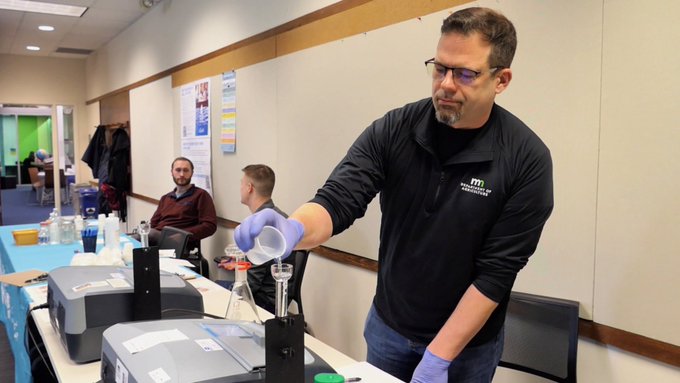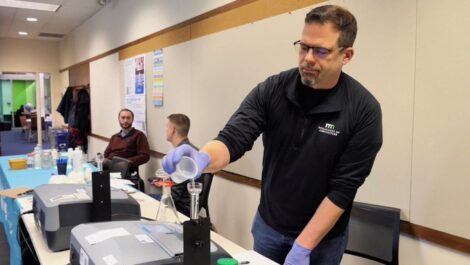Farmfest nitrate tests reveal private well water issues
Tests show private wells above federal standards

Photo courtesy of Minnesota Department of Agriculture Soil Scientist Travis Hirman. Minnesota Department of Agriculture staffer Tom Bolas, right, pours private well water into a spectrophotometer at a Dakota County Nitrate Testing Clinic.
BROWN COUNTY — The Minnesota Department of Agriculture (MDA) reports water from six private wells tested at Farmfest exceeded the federal health standard for nitrate-nitrogen this year.
Another nine private wells showed elevated levels.
Three of every four Minnesotans rely on groundwater for their drinking water–making its protection a statewide concern.
“Unsafe nitrate levels can be a hidden danger in Minnesota well water,” said MDA Commissioner Thom Petersen. “Af Farmfest, we uncovered those risks and gave families immediate answers to protect themselves.”
Travis Hirman, MDA soil scientist, said water test locations are based on townships meeting criteria including vulnerable, sandy soil; shallow, poorly constructed wells, proximity to crop fields or manure and geology like fractured limestone.
“One young family with a newborn learned their water wasn’t safe. They left our booth with answers and options,” said Denton Breuning, a water quality expert who led the free testing clinic.
The MDA identified townships throughout the state that are vulnerable to groundwater contamination and have significant row crop production. More than 90,000 private well owners have been offered nitrate testing in 344 townships since 2013.
A total of 107 wells in Mulligan, Leavenworth and Stark townships were selected in Brown County for testing in 2019. In Mulligan Township, 8.3% of the wells were above the federal health standard for nitrate-nitrogen. There were 5.7% of Leavenworth Township wells above the standard and 2.8% in Stark Township.
Testing in Ridgely Township in Nicollet County showed 13.6% of 26 wells tested over the federal standard.
Swedes Forest Township in Redwood County was selected for testing based on its vulnerable geology and row crop agriculture. Results showed 6.7% of 15 wells tested were above the federal standard.
Riverdale Township in Watonwan County was selected for MDA testing based on its vulnerable geology and row crop agriculture. Results showed 6.8% of 44 wells tested were above the federal standard.
Fairview and Westerheim Townships in Lyon County were tested for nitrates. Results showed 15.4% of 13 Westerheim Township wells tested above the federal standard. Twenty-four Fairview Township wells were tested, but there were no wells above the federal standard. Not all homes in the townships use private wells for drinking water. Many homes in these areas are on a rural water supply.
Verdi Township in Lincoln County was selected for testing. Results showed 57.1% of seven wells tested were above the federal standard. Not all homes in Verdi Township use a private well for drinking water. Many homes are on a rural water supply.
Barber, Prescott and Winnebago Townships in Faribault County were selected for testing. No wells among 134 tested showed were above the federal standard.
Nitrate in drinking water is a serious health concern–especially for infants under 6 months of age and pregnant women. Nitrate is undetectable through smell or taste. Testing is required to determine if it is present–and at what level.
The Minnesota Department of Health recommends wells be tested annually for nitrate and other contaminants.
The MDA maintains nitrate well testing equipment statewide in partnership with local Soil and Water Conservation Districts and organizations like the Minnesota Well Owners Organization.
Community groups, counties, and lake associations interested in hosting clinics are encouraged to reach out to the MDA.
For more information, more information, visit https://content/govdelivey.com/accounts/MNMDA/bulletins/3f0d352.




